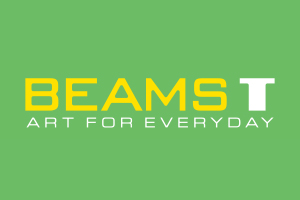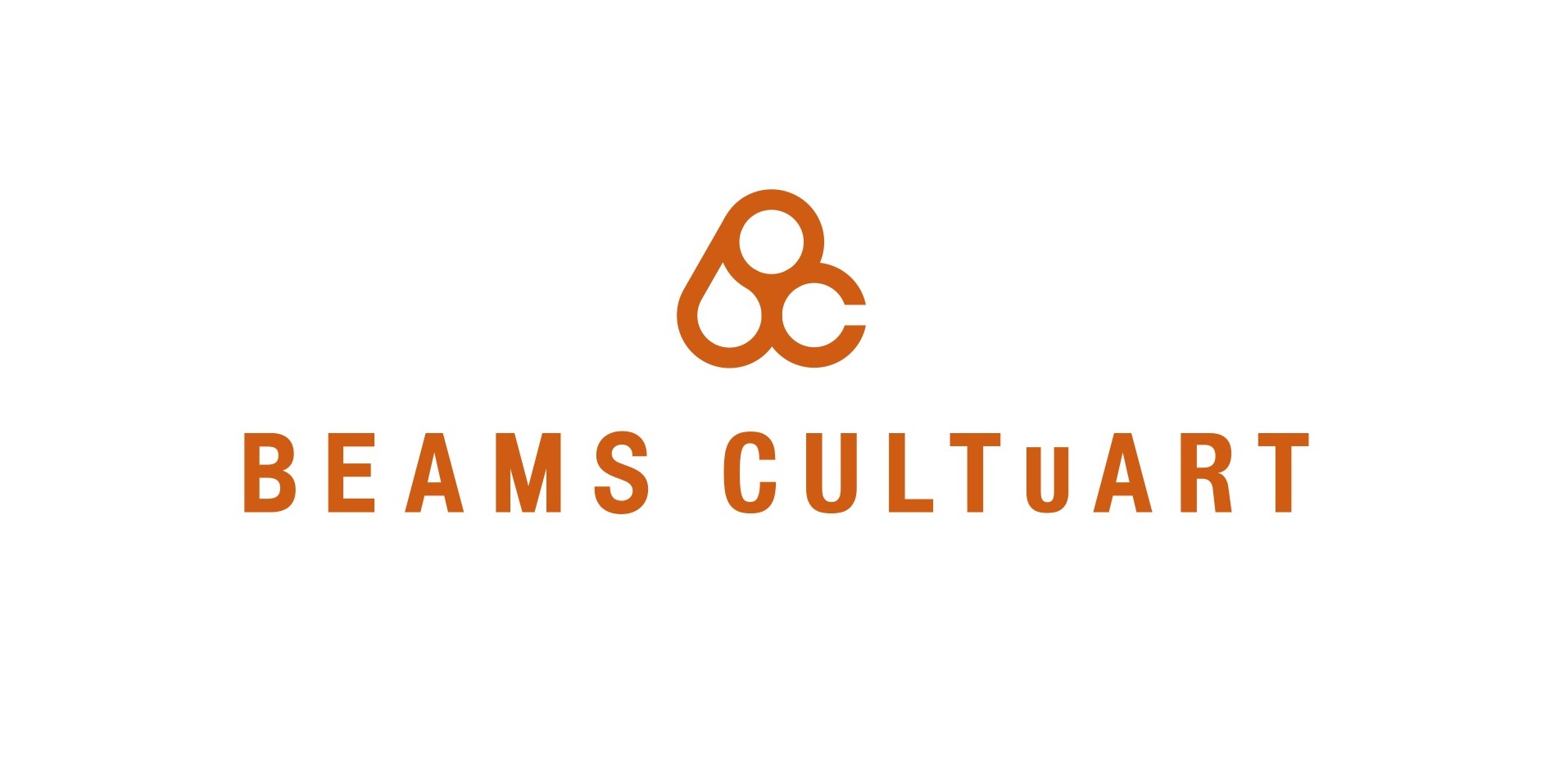
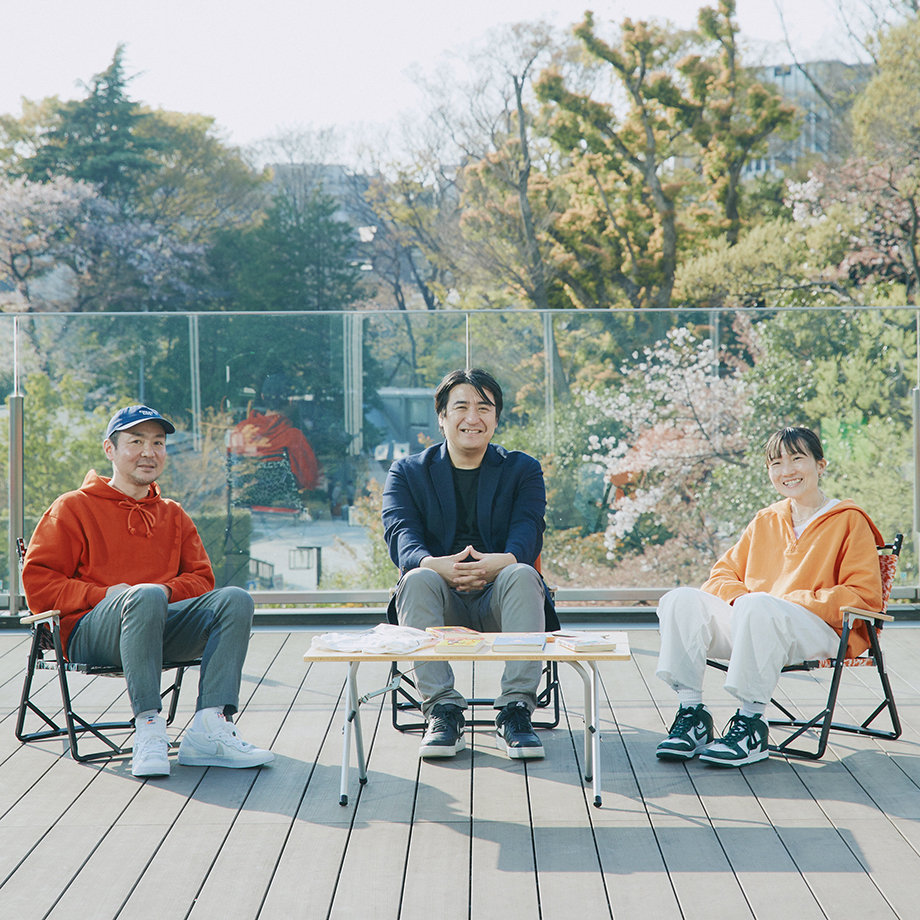
マンガート ビームスが佐久間宣行Pと組んだワケ。
The reason why MANGART BEAMS teamed up with producer Nobuyuki Sakuma.
漫画やアニメを題材にしたTシャツレーベル〈マンガート ビームスT〉がスタートしたのが2008年。そこから14年の歳月が過ぎ、満を持してリスタートしたのが〈マンガート ビームス(以下マンガート)〉です。セカンドシーズンは、マンガやアニメのみならず、ゲーム、アイドル、テレビなどポップカルチャーを全方位的にフォーカスします。そして、リスタートを切るにあたり、ステートメントの制作を依頼したのがテレビプロデューサーの佐久間宣行さん。なぜ彼に白羽の矢が立ったのか、そして〈マンガート〉が目指す先は。佐久間さんと〈マンガート〉の担当者2人で送る、ポップカルチャー座談会。
MANGART BEAMS T, a T-shirt label based on manga and anime, was launched in 2008. Fourteen years have passed since then, and MANGART BEAMS (hereafter referred to as "MANGART") has now been relaunched. The second season will focus on all aspects of pop culture, including not only manga and anime, but also video games, idols, and television. And for the relaunch, we asked TV producer Nobuyuki Sakuma to create the statement. Why was he chosen and what is MANGART’S goal? Mr. Sakuma and two project members of MANGART will discuss pop culture in this roundtable discussion.
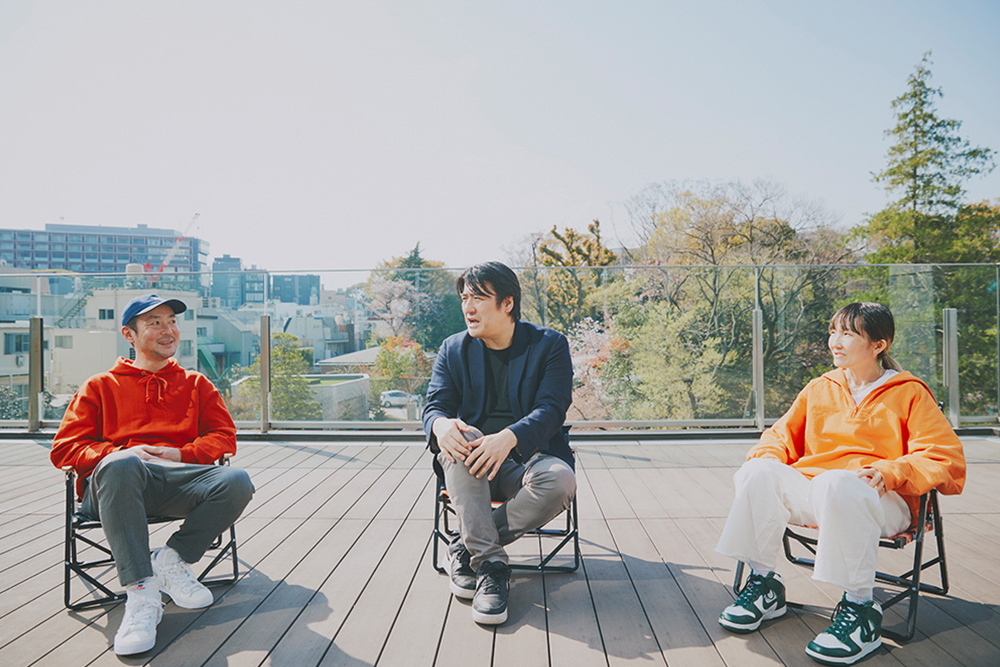
PROFILE
佐久間宣行
(テレビプロデューサー)
1975年生まれ、福島県いわき市出身。大学卒業後に「テレビ東京」に入社し、入社3年目という異例の早さで深夜番組『ナミダメ』のプロデューサーに。その後も『ゴッドタン』や『ウレロ☆シリーズ』『あちこちオードリー』など数多くの作品を生み出す。2021年に「テレビ東京」を退社。現在もテレビ、ラジオ、配信と、活動は多岐にわたる。
入江和宏
(ビームス クリエイティブ / プロデューサー)
1997年入社。メンズカジュアルの銀座、原宿店舗スタッフを務めた後、〈ビームスT〉ディレクターに就任。その後〈マンガート ビームスT〉を立ち上げ、〈ビームス創造研究所〉などを経て現職に。〈マンガート〉にはプロジェクトメンバーとして参加。
橘高つむぎ
(ビームス クリエイティブ アートディレクター / プロデューサー)
2007年入社。アルバイトからはじまり、ロジスティック部を経て、アウトレットを統括する部署で働きながら学校でデザインを学ぶ。学校卒業後に制作部へ異動し現職に。アニメ、マンガ、アイドルが大好き。入江と同じく〈マンガート〉にはプロジェクトメンバーとして参加。
佐久間Pのエンタメ漬けな日々。
入江:本日は、よろしくお願いします。
佐久間:こちらこそよろしくお願いします。それより、この椅子に座ってると、俺すげー巨人じゃない? 大丈夫ですか?
橘高:全然大丈夫です(笑)。
佐久間:ならよかった。今日、めちゃくちゃ真面目な講演会やってきたから、ジャケットを着てるんですよ。ジャケットも大丈夫ですかね?
橘高:はい、ジャケットで全然大丈夫です(笑)。

入江:ここ最近、佐久間さんは作品ラッシュが続いてますよね。
佐久間:去年の12月から今年の3月までは、正直めちゃくちゃ大変でした(笑)。
入江:3月からNetflixで配信になった『トークサバイバー』も、素材がたくさんありそうですもんね。
佐久間:30分×8話で、45分の回もあるから、トータル5時間ぐらいか。その時間の映画を編集するって言ったら、大変ですよね。
橘高:その間にLINEライブであったりYouTubeもやられてますもんね。
佐久間: YouTubeは週2回もやるつもりじゃなかったんですけど、週2回やった方がいいって言われて。それを鵜呑みにしたら、他の人は普通に喋るだけだけど、俺の場合はもう番組をつくってる感覚だから大変で。
入江:そんな忙しいなかでも、ラジオであったりテレビであったり映画を観てるわけじゃないですか。いつも橘高と「佐久間さんは寝てないよね」って話してるんです。
佐久間:そんなことないですよ、本当に。5時間ぐらいは寝てます。昨日も3時まで映画を見てて、8時に起きて、9時から仕事みたいな感じで。どっちかって言うと、見ることがストレス解消で、見る時間が無くなってくるとカリカリするんです。

橘高:オフの日もずっと観たり聴いたりっていう感じですか?
佐久間:そうですね。会社にいた時も、ちょっとした移動中にNetflixとか観てるから、変態だなって言われてました(笑)。
入江:メディアはどんどん増えていくじゃないですか。YouTubeもあるし、テレビも見逃し配信があって。
佐久間:昔は芸人のライブも、行けなかったら謝れば済んだけど、いまは「配信送ります」とかあるしね。昨日も「空気階段」の単独ライブに行けなくて、配信が送られてきたから、今日中に見なきゃ。
橘高:実際に舞台なんかにも行かれていますよね。
佐久間:今週末も「劇団あはひ(読み:あわい)」っていうのを見に行きますよ。
入江:どういう方たちなんですか?
佐久間:早稲田の学生たちがやっているんですけど、ある時ラジオの出待ちをしてくれていて。見に行ってみたらおもしろくて、それから通っているんです。能とトランスをミックスするっていう(笑)。才能ありますよ。
ー 忙しい中で、そうした無名の方にもアンテナを伸ばすというのがすごいです。
佐久間:単純にわけわかんない人を見るのが好きなんですよ。
なぜ、佐久間Pだったのか。
ー そろそろ本題に入っていきたいのですが、まずは〈マンガート〉の説明を簡単にお願いします。
入江:もともと〈マンガート ビームスT〉という名前で、2008年にはじめたんです。その頃、自分が〈ビームスT〉のディレクターをやっていて、マンガが好きなこともあり、レーベル内のプロジェクトとしてスタートして。

ー そこから今年の復活までは、お休みしていたと。
入江:実はプロジェクトは残っていて、単発で企画をやったりはしていたんです。でも今回のリスタートで、これまでマンガとアニメにしかフォーカスしていなかったんですけど、ゲームやアイドル、演劇、テレビなどのポップカルチャー全般に間口を広げています。
ー ちなみに佐久間さんは、BEAMSって通ってきましたか?
佐久間:もちろん。俺らの世代にとってみたらスタンダードな存在なので。あと、BEAMSって意外とサイズ展開があるんですよ。180センチ以上ある俺でも、着られるものがちゃんとある(笑)。
ー これまで、BEAMSと佐久間さんの取り組みってあったんでしょうか?
佐久間:初めてです。基本的にバラエティディレクターなので、映画や音楽なんかのカルチャーの仕事はよくあるんですけど、まさかBEAMSからお仕事をお願いされるとは思わなかったですよ。

ー どういう経緯で、佐久間さんへステートメントの製作を依頼するに至ったんですか?
橘高:再始動するにあたって、いろんな部分を刷新するなかで、「プロジェクトのステートメントが欲しいよね」ってなったんです。もちろん言葉のプロにお願いする案もあったんですけど、もうちょっと私たちに近いカルチャーを通っていたり、エンタメが好きな方に、等身大の飾らない言葉で書いて欲しかったんです。そう考えた時に、佐久間さんがぴったりで。
ー 2人とも、佐久間さんが好きだったと。
橘高:大好きでした(笑)。
入江:正直、それだけの理由でした(笑)。一緒にお仕事したい、みたいな。
佐久間:自分、なんでか分からないけど、アパレル関係の人にめちゃくちゃファンが多いんですよ。
入江:今日も佐久間さんとご一緒できるから、休憩時間に『あちこちオードリー』見てましたもん。
佐久間:いや、もう本当にありがとうございます(笑)。
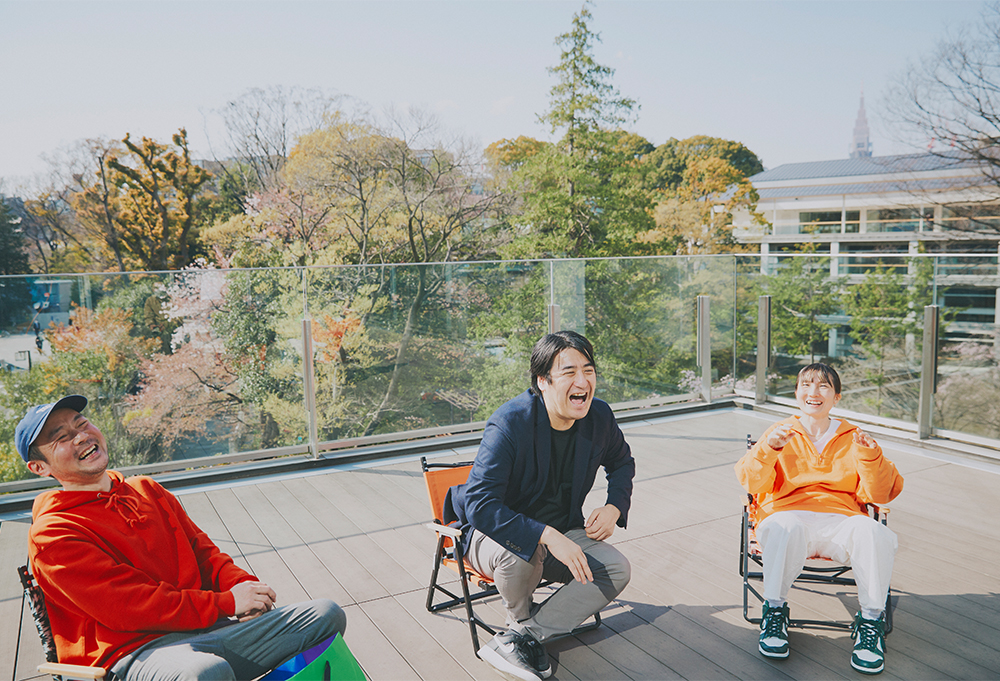
BE-POP
面白いものや、好きなもので、
世界を満たしたい
好きなものに囲まれた世界は、
きっと楽しいから
ポップカルチャーで、生活を、人を彩ること
それが、この世界で生きていく
強さになるはず
ポップになろう、ポップと生きよう。
ー ステートメントを依頼するにあたって、どのようなリクエストをされたんでしょうか?
橘高:〈マンガート〉がこれからやっていきたいことをお伝えした上で、佐久間さんらしく短い言葉で分かりやすいものを、とお願いさせてもらいました。漫画の帯に書かれていた佐久間さんの推薦コメントを見て、そのカジュアルさが良いなと思ったんです。
佐久間: それを聞いて、“BE-POP(ビーポップ)” っていう言葉を思いついたんです。ジャズで使われるBEBOPをもじったんですよ。「ビームス」のBもあるし、「ポップ」っていう言葉も入ってるし、語呂も良いかなと思って。で、BE-POPの流れから、ステートメントの草稿を書いたって感じですね。
ー 実際に佐久間さんからステートメントが送られてきたときはどうでした?
入江:橘高とハイタッチしましたよ(笑)。
橘高:BE-POPが出た時点で、これはもういけると思いました。
佐久間:ハイタッチしているとか教えてくれたらよかったのに(笑)。半年前くらいに提案させていただいたんですけど、こうやって形になってみると、半年前の自分は頑張ったなって思います。いい標語だなと。

ー ステートメントでは“ポップ”という言葉がキーワードになっていますよね。
佐久間:打ち合わせの時に「ポップカルチャーに救われた経験がある」っていう話をしていただいたのが、すごい心に残っていて。俺もそうだし、〈マンガート〉のものを着る人たちはきっとそうだと思うんです。好きなものを身に纏ったり、好きなものに囲まれているから、辛いことも乗り越えられる。そんなポップカルチャーに対するイメージを、ステートメントに込めました。
ー そもそも、ポップカルチャーとサブカルチャーの違いって、なんなんでしょうか?
入江:サブカルって、あくまでメインがあってのサブですけど、いまはメインがないですよね。10,20年前と今では、サブカルの持つ意味も変わってきていると思います。だから、〈マンガート〉がこれから触れていきたい領域を言い表すには、ポップカルチャーという言葉が最適なのかなと。
佐久間:サブスク配信とかも含めて、いろいろコンテンツが多様化していくと、どれがメインカルチャーっていうのは言えないので。今の時代を捉えているものは全て、ポップカルチャーとして括るのもありかなと思っています。
ー そんな〈マンガート〉では、今どんな企画を仕込んでいるんですか?
入江:8月に「さいたまスーパーアリーナ」で、『アニメロサマーライブ』という、日本国内で一番大きいアニソンのイベントがあるんですよ。その協賛をさせていただくことになっています。
橘高:私自身も10年以上通っているイベントなので、関われたことがめちゃくちゃうれしいです。
入江:今後はものづくり以外にも、例えばディレクションみたいなもう一歩踏み込んだことをやっていきたいなって思ったりしてます。
みんなが影響を受けたポップカルチャー。
ー 話は変わりますが、今日はみなさんに自身が影響を受けたものを持ってきていただきました。まずは佐久間さんからお願いします。
佐久間:ちょっと今日、持って来れなくて…ごめんなさい。実際には持ってきたんですけど、制作会社に置き忘れてきちゃって。

ー ちなみに、何だったんですか?
佐久間:原体験みたいなところで言うと、アイザック・アシモフっていうSFの始祖が書いた『ファウンデーションと地球』っていう小説です。彼はロボット三原則(第一法則:ロボットは人間に危害を加えてはならない。またその危険を看過することによって、人間に危害を及ぼしてはならない。 第二法則:ロボットは人間に与えられた命令に服従しなくてはならない。ただし、与えられた命令が第一法則に反する場合はこの限りではない。 第三法則:ロボットは前掲の第一法則、第二法則に反するおそれのない限り、自己を守らなければならない。 )をつくった人で、大学時代に読んで衝撃を受けました。いまApple TVでも、この小説のドラマを配信しているんですよ。
ー 意外にも小説なんですね。
佐久間:俺が知る限り、彼は『ファウンデーションと地球』でいくつかの作品をユニバース化(作品で描かれた世界観がほかの作品でもそのまま用いられること)した初めての人だと思うんです。とにかくとんでもないことをする天才で、今の『MCU(マーベル・シネマティック・ユニバース) 』の感動に近いものが大学時代にありまして。そこから創作はなんでもアリなんだなと、想像力を止めないようにしようと思ったんですよね。
ー ありがとうございます。では、お次に入江さん、お願いできますか?
入江:11年前くらいですかね、「ももクロ」にどハマりしたんです。その時はまだ〈ビームスT〉のディレクターをやっていて、自分で色々企画を考えられる立場だったので、「ビームスT 原宿」で3日間、「ももクロ」のイベントをやったんです。
佐久間:当時、ニュースにもなってましたよね。覚えてるな。
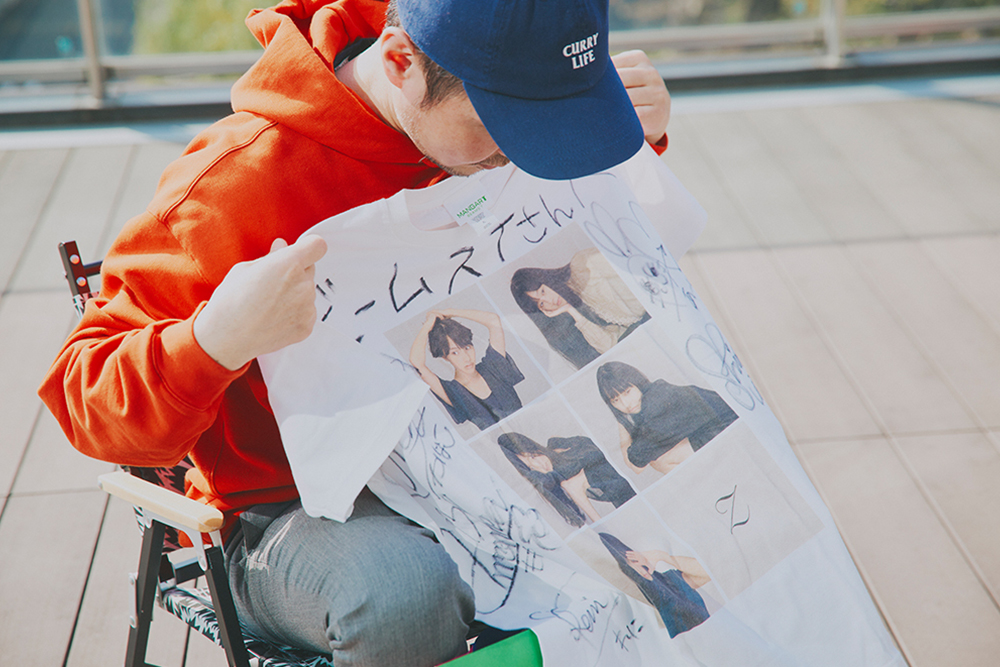
入江:初日の朝は200人くらい並びが出て、最終日には「ももクロ」のメンバーがドッキリで来店してくれるという。そこで売っていたTシャツに、メンバーのみんなにサインしてもらったものがこれで。今でも、そのイベントの時に仲良くなった方とは繋がっているし、ひとつの共通言語があるだけで10代から60代まで年齢関係なく話せることを知れた機会でした。なので、自分の中で「ももクロ」の存在はターニングポイントなんです。
佐久間:俺もこの頃の「ももクロ」とはよく仕事してたんですよ。『ゴッドタン』もそうだし、『ウレロ☆シリーズ』を立ち上げた時は、「ももクロ」を辞めたばかりの早見あかりをレギュラーで起用させてもらったり。早い段階でカルチャーと融合したのは「ももクロ」ですよね。
橘高:当時はアイドル戦国時代だったし、「ももクロ」はその象徴でもあるなと。私も大好きで、「中野サンプラザ」でやった早見あかりちゃんの卒業ライブは見にいきましたね。
ー 次はなんでしょうか?
入江:すごいパーソナルなことになっちゃうんですけど。佐久間さん、実はぼく、弟が「カラテカ」の入江なんです。
佐久間:えー、そうなんですか?
入江:口にはしないけど、弟とはお互い影響を与え合ってきた仲だと勝手に思っています。弟がポップカルチャー領域にいたことが、自分にとっても良い刺激になっていたので。芸能界引退する前に、何十年ぶりに単独ライブをやったんです。そのチケットの半券が、なんか捨てられなくて。

佐久間:めちゃくちゃいい話じゃないですか(笑)。
ー 佐久間さんは「カラテカ」入江さんとお仕事されたことありますか?
佐久間:ほとんどしたことがないですね。というのも、ぼくが20代の後半ぐらいに番組をつくろうとなったタイミングで、『やりすぎコージー』が始まって、関西吉本の大ブームが来たんです。だから、ある程度戦略的に関西吉本の人たちとは絡まず、関東芸人を起用しようと思って。それが、当時まだ売れていなかった「バナナマン」や「おぎやはぎ」「東京03」、「劇団ひとり」でしたね。
入江:『トークサバイバー』もそうですけど、佐久間さんの番組に出ているメンバーは図られたようにみんな売れていますよね。「ハライチ」の岩井さん、ヒコロヒーさんとか。
佐久間:「錦鯉」の渡辺くんとかね。もう言っていいと思うんだけど、人を見る目には自信がある(笑)。
橘高:絶対そうですよ。それって直感なんですか?
佐久間:誰でも調べれば半分ぐらいには絞れると思っていて、そこから先は直感です。あとは、その人にまだ底があるかどうかを見ますね。
ー では、次に橘高さんの思い出の品を教えてください。
橘高:『岸谷五朗の東京RADIO CLUB(以下レディクラ)』が、私のラジオ原体験で。22時から24時までの帯でやっていて、しかも週に1回、ちょっとエロい日があるみたいな。 当時中1だったこともあって、夜更かししていたり、そういう話を聞く背徳感が好きでした。クラスのみんなは知らないけど、局所的に盛り上がっていたっていうのもまたよくて。当時買ったのが、このラジオ本です。

佐久間:たしか『レディクラ』は、自分が高校とか大学ぐらいの時だったかな。いい番組でしたよね。
橘高:『レディクラ』放送中に岸谷さんの俳優業が忙しくなっていって、結局ラジオは終わっちゃうんですけど。そのサクセスストーリーを視聴者みんなで目の当たりにしている感じがよかったんです。テレビに出るようになる前から応援していた人がどんどん売れていくのは、嬉しくもあり、寂しい部分もある。そういう経験を初めてしたのが、『レディクラ』でした。
ー お次は何でしょうか?

橘高:高橋留美子先生の『らんま1/2』ですね。
佐久間:なんで2巻なんですか?
橘高:この巻で登場する響良牙(ひびきりょうが)は、2次元で初恋したキャラなんです。私が好きになるアイドルやキャラクターは王道だったり絶対的なセンターというよりは、2番手であったり、絶対に報われなさそうな人が多くて。響良牙はそうした嗜好の原体験になっています。ちなみに、アイドルを好きになったきっかけも、『らんま1/2』のアニメのテーマ曲だったんです。
佐久間:永作博美さんがいた「ribbon」ですよね。
橘高:そうです。なので、『らんま1/2』には、私の原体験がたくさん詰まってるんです。
〈マンガート〉の次なる企画。
ー 橘高さんは今日、佐久間さんに見せるために〈マンガート〉で今後やっていきたい企画を考えてきたんですよね。
橘高:フリップ風にしてきました(笑)。まず考えたのが「BEAMSに行けば会えるアイドルプロジェクト」。

ー どういうものですか?
橘高:BEAMSには1000人以上のスタッフがいるので、その中からオーディションしてアイドルグループをつくりたいなと。何回かオーディションをして、10人くらいになった段階で、投票をお客様のお買い物金額にしたら面白いんじゃないかなと思ってます。彼女たちはショップスタッフだから、お店まで足を運んでもらえれば実際に会えるので。アイドル戦国時代が落ち着いた今、会えるアイドルをBEAMSでやりたいっていう企画です。
佐久間:いいじゃないですか。BEAMSのカジュアル感とアイドルの組み合わせは、ありそうでないから、おもしろそう。
ー ほかにはありますか?
橘高:『マジ歌選手権』のグッズをプロデュースさせて欲しいです。ぜひお願いします(笑)。
佐久間:これは俺の一存では決められないけど、テレビ東京には話しておきます(笑)。
ー ちなみに、佐久間さんは企画を立てる時にどういう風に考えているんですか?
佐久間:「なんで俺だけ面白くないんだろう」「なんで俺だけ笑っちゃったんだろう」とか、そんな感情や違和感を覚えておくんです。そんなのがいくつか溜まった時に、公式が見えてくるんですよ。その公式をもとに、企画にしてみようっていうのが多いですかね。俺だけ面白い時は、他に分かっていない人がたくさんいるってことなので、世の中の人が分かるようにこうしようああしようって考えると、それが企画になるんです。
ー 自分の感情をメモされてたりするんですか?
佐久間:企画の簡単なメモはしてますね。誰が、何をして、こうなる、みたいな3行くらいのメモを。後から見ると、宝物が眠っていたりしますから。
ー それでいうと、『トークサバイバー』はどんな発想で生まれたんですか?
佐久間:恋愛番組の『テラスハウス』ってあるじゃないですか。ぼく、あれ見てゲラゲラ笑っちゃうことがあったんですよ。「お前、何言ってんの」みたいな。それって、真面目なことをかっこつけて喋ってるから面白いんだなあと思って。芸人のトークをドラマのトーンで『テラスハウス』みたいに撮ったら面白いんじゃないかと。
ー 佐久間さんが〈マンガート〉で企画するなら、どんなものをつくりますか?
佐久間:大喜利と組み合わせたりしてもいいかもしれないですね。“Tシャツ大喜利選手権”とか、いくらでもできそう。例えば、「麒麟」の川島さんがやってるハッシュタグ大喜利みたいなこととか。
橘高:大喜利Tシャツ販売して、SNSでみんなに答えてもらうのも面白そうですよね。
佐久間:もしくは、お題だけ書かれたTシャツ。それと遭遇したら、大喜利しなきゃいけないみたいなね(笑)。

入江:最後に真面目な話になっちゃうんですけど、配信演劇舞台『あの夜を覚えてる』の初日に佐久間さんからの挨拶があったじゃないですか。
佐久間:そこまで見ててくれたんですか?
入江:あの言葉がすごい自分にも刺さって。
佐久間:説明させてもらうと、生放送の配信舞台なんですけど、始まる前に出演者全員に喝を入れなきゃいけなくて。本当は別の監督がやるはずだったんだけど、彼がそういうのが苦手だっていうので、俺がやらなきゃいけなくなったんです。で、咄嗟に「僕はどんなにくだらない作品を出す時でも、誰かの人生が変わればいいなと思ってます。今日みなさんが準備したものは素晴らしいものだから、世の中の誰かの人生を変えられると思うから、変えてきちゃってください」って言ったんです。ちょっとカッコつけ過ぎたなとも思うんですけど(笑)。
入江:本当、刺さりましたね。似たような経験が僕にもあって。知人が、知らないところで自分が企画したものをすごく大事にしてくれていたことがあったんです。彼の人生に少しでも関われているのがうれしくて。だから、この〈マンガート〉でも、誰かの人生に携われる企画を生み出せたらって思ってるんです。

PROFILE
Nobuyuki Sakuma
(TV Producer)
Born in 1975 in Iwaki City, Fukushima Prefecture. After graduating from university, he joined “TV Tokyo” and became a producer of the late-night program “Namidame” in his third year with the company, which was unusually early. He continued to produce numerous works, including “God Tongue,” “Urero☆Series,” “Achikochi Audrey,” and many more. In 2021, he retired from TV Tokyo. He continues to be active in a wide range of fields, including television, radio, and online streaming.
Kazuhiro Irie
(BEAMS Creative / Producer)
Joined the company in 1997. After working as a staff member at men’s casual stores in Ginza and Harajuku, he became a director of BEAMS T. He then launched MANGART BEAMS T and worked at BEAMS Creative Institute before assuming his current position. He participates in MANGART as a project member.
Tsumugi Kittaka
(Art Director/Producer, BEAMS Creative)
Joined the company in 2007. Starting as a part time job, she worked in the Logistics Department and then in the department that oversees the outlets while studying design in school. After graduating from school, she moved to the Production Department to take her current position. She loves anime, manga, and idols. Like Irie, she is a project member of MANGART.
Producer Sakuma’s entertainment-soaked days.
Irie: Thank you very much for your time today.
Sakuma: Thank you for having me. By the way, sitting in this chair, don’t I look like a huge giant? Is that all right?
Kittaka: Totally fine (laughs).
Sakuma: I’m glad to hear that. I’m wearing a jacket because I gave a very serious lecture today. Is the jacket okay too?
Kittaka: Yes, that’s fine as well (laughs).

Irie: Lately, you have been flooded with work, haven’t you?
Sakuma: To be honest, from December of last year to March of this year there was a lot of work (laughs).
Irie: “Talk Survivor,” which became available on Netflix in March, seems to have a lot of material, doesn’t it?
Sakuma: There are 8 episodes of 30 minutes each, with some 45-minute episodes, so about 5 hours in total. It’s a lot of work to edit a film of that length, isn’t it?
Kittaka: In the meantime, you also do LINE Live and YouTube.
Sakuma: I wasn’t planning on doing YouTube twice a week, but I was told I should do it biweekly. I blindly trusted their word, but it’s been a lot of work because other people just talk normally, but in my case, I make a show.
Irie: Even with such a busy schedule, you still listen to the radio, watch TV and movies. Kittaka and I always say, “Sakuma never sleeps.”
Sakuma: That’s not true, really… I sleep for about 5 hours. Last night, I was watching a movie until 3:00 am, woke up at 8:00 am, and started working at 9:00 am. If anything, watching something is a stress reliever, and when I don’t have time to watch, I get irritated.

Kittaka: Do you watch and listen to something all the time, even on your off-days?
Sakuma: Yes, I do. Even when I was working at a TV station, I was told I was obsessed because I watched Netflix or something while I was on the road for a bit (laughs).
Irie: The number of media types is increasing rapidly, isn’t it? There’s YouTube, and there’s online reruns of TV shows.
Sakuma: In the past, you could just apologize if you couldn’t make it to a comedian’s live show, but nowadays, they’d say, “I’ll send you the link.” Yesterday, too, I couldn’t make it to the live performance of Kuki Kaidan, but I received the link, so I have to watch it today.
Kittaka: You go to theaters often, don’t you?
Sakuma: I’m going to see a play by Gekidan Awai this weekend, too.
Irie: What kind of people are they?
Sakuma: They are students at Waseda University. One day they were waiting for me at the exit of the radio station to say hi to me. I went to see them and found them interesting, and I have been seeing their plays ever since. They mix Japanese Noh and trance music(laughs). They are very talented.
ー We’re amazed that you can keep your radar open for such an unknown group in the midst of your busy schedule.
Sakuma: I simply like to look at people I don’t understand.
Why was it Producer Sakuma?
ー We would like to get down to business, but first, please give us a brief explanation of MANGART.
Irie: I originally started it in 2008 under the name MANGART BEAMS T. I was the director of BEAMS T at the time, and since I love manga, I started it as a project within the label.

ー And the project was on hiatus until its revival this year, wasn’t it?
Irie: Actually, the project remained, and we did some one-off projects. But with this relaunch, we have expanded our focus from manga and anime to include all aspects of pop culture, including video games, idols, theater, and television.
ー By the way, Mr. Sakuma, were you familiar with BEAMS and its culture?
Sakuma: Of course. It is a standard for our generation. Also, BEAMS has a surprisingly wide range of sizes, so even though I am over 6 feet tall, there are things I can wear (laughs).
ー Have BEAMS and Mr. Sakuma ever worked together before?
Sakuma: This is our first time. Basically, I am a variety show director, so I often work on cultural projects such as movies and music, but I never thought I would be asked to work for BEAMS.

ー How did you come to ask Mr. Sakuma to produce the statement?
Kittaka: With the relaunch of the project, we were in the process of revamping various parts of the project, and we decided that we wanted a statement for the project. Of course, there was the idea of asking a professional wordsmith to write it, but we wanted someone who had been through a culture closer to ours or who liked entertainment to write it in his or her own honest and unadorned words. When I thought about it, Mr. Sakuma was the perfect person for the job.
ー You both liked Mr. Sakuma, didn’t you?
Kittaka: Loved him (laughs).
Irie: To be honest, that was the only reason (laughs). We wanted to work with him.
Sakuma: don’t know why, but I have a lot of fans in the apparel industry.
Irie: I was watching “Achikochi Audrey” during break time because I got to work with you today.
Sakuma: Thank you so much (laughs).

BE-POP
We want to fill the world
with interesting things, and things we like.
We’re sure the world is a better place
when you are surrounded by things you like
To color our lives and people with pop culture
will give us strength to live in this world
Let’s be pop. Let’s live with pop.
ー What kind of request did you have in mind when you asked for the statement?
Kittaka: We told him what we wanted to do with MANGART in the future, and then asked him to use short, easy-to-understand words, just like Mr. Sakuma. I had seen Mr. Sakuma’s recommendation written on the cover of a manga, and I had thought the casual nature of it was good.
Sakuma: When I heard their explanation, I thought of the term “BE-POP.” It is a play on the word “bebop,” which is used in jazz. There is a “B” in “beams” and the word “pop” is also in it, so I thought it would be a good word. So I drafted the statement from the flow of thinking of the term BE-POP.
ー How did you feel when you actually received the statement from Mr. Sakuma?
Irie: I high-fived Kittaka (laughs).
Kittaka: As soon as BE-POP came out, I knew it was good.
Sakuma:You should have told me you were high-fiving (laughs). I made the proposal about six months ago, and now that it has taken shape like this, I think I did good six months ago. It’s a good motto.

ー We can see that “pop” is a key word in your statement.
Sakuma: I was really impressed when they mentioned during our meeting that they had an experience of being saved by pop culture. I think that’s true for me, and I’m sure it’s true for the people who wear MANGART’s clothes. Wearing what you love and being surrounded by what you love helps you get through hard times. I put such images of pop culture into my statement.
ー What is the difference between pop culture and subculture in the first place?
Irie: Subculture is a subculture because there is a main culture, but nowadays there seems to be no main part. I think the meaning of subculture has changed from 10 or 20 years ago to now. So, I think the word “pop culture” is the best way to describe the area that MANGART wants to cover in the future.
Sakuma: With the diversification of content, including subscriptions, it is difficult to say which is the main culture. I think that everything that captures the current era can also be lumped together as pop culture.
ー What kind of projects is MANGART working on at the moment?
Irie: In August, there will be the biggest anime song event in Japan called “Animelo Summer Live” at the Saitama Super Arena. We are going to sponsor the event.
Kittaka: I have been going to this event for more than 10 years, so I am very happy to be involved.
Irie: In the future, I would like to do more than just making things; I would like to take things one step further, like directing.
Pop culture has influenced all of us.
ー Let us change the subject, but today we have asked you to bring something that has influenced you. Let’s start with you, Mr. Sakuma.
Sakuma: I’m sorry I couldn’t bring anything today. Actually, I did, but I left it at the production company.

ー What was it, by the way?
Sakuma: I would say that my turning point was when I read a novel called “Foundation and Earth” written by Isaac Asimov, the founder of science fiction. He is the creator of the Three Robot Principles (1st principle: Robots must not harm humans, nor harm humans by overlooking the danger. 2nd principle: A robot must obey commands given by humans. However, this does not apply if the given order is contrary to the first principle. 3rd principle: The robot must protect itself unless there is a risk of violating the first and second principles above.), which I read in college and was shocked by. Now Apple TV is offering a drama based on this novel.
ー It is a surprise that you chose a novel.
Sakuma: As far as I know, Asimov was the first to use the worldview of “Foundation and Earth” in other works, creating a so-called “shared world.” He was a genius who did extraordinary things, and I was very impressed during my college years with his ideas, just like people now are impressed by the “Marvel Cinematic Universe (MCU)”. That’s when I realized that anything is possible in creation, and that I should never stop imagining.
ー Thank you very much. Next, Mr. Irie, could you show us what you brought?
Irie: It was about 11 years ago that I got hooked on Momoiro Clover Z. At the time, I was still the director of “BEAMS T” and in a position to come up with various projects on my own, so I held a 3-day “Momoclo” event at BEAMS T HARAJUKU.
Sakuma: It was in the news at the time, wasn’t it? I remember that.

Irie: On the morning of the first day, there were about 200 people in line, and on the last day, the members of “Momoclo” came to the store as a surprise. This is a T-shirt that was sold there and signed by all the members. Even now, I am still connected with the people I befriended at that event, and it was an opportunity for me to learn that just by having one common interest, I could talk to people from teens to 60s, regardless of age. So, “Momoclo” is a turning point for me.
Sakuma: I used to work with “Momoclo” a lot in those days. “God Tongue” was one example, and when we launched the “Urero☆Series,” we used Akari Hayami, who had just quit Momo Kuro, as a regular performer. It was “Momoclo” that fused with the culture at an early stage, wasn’t it?
Kittaka: Those were the days of the “Idol Wars,” and “Momoclo” was a symbol of that. I also loved them and went to see Akari Hayami’s graduation live at Nakano Sunplaza.
ー What’s next?
Irie: This is going to get very personal. Mr. Sakuma, actually, my younger brother is Irie of “Karateka”.
Sakuma:Wow, is that so?
Irie: Although we don’t talk about it, I selfishly believe that my brother and I have influenced each other. My brother’s being in the pop culture realm was a good stimulus for me as well. Before he retired from show business, he did a live solo show for the first time in decades. I couldn’t throw away the ticket stub.

Sakuma: Isn’t that a very nice story (laughs)?
ー Have you ever worked with Mr. Irie of “Karateka”?
Sakuma: I have hardly worked with him at all. I was in my late twenties when I decided to create a TV show. Around that time, “Yarisugi Koji” started, and there was a big boom in Kansai(western Japan) Yoshimoto comedians. So, to some extent, I strategically decided to use Kanto(eastern Japan) comedians instead of Kansai Yoshimoto comedians. That was “Bananaman,” “Ogi Yahagi,” “Tokyo03,” and “Gekidan Hitori,” who were not yet successful at the time.
Irie: I think that the members of Mr. Sakuma’s programs, such as “Talk Survivor,” all become successful, like Mr. Iwai of “Haraichi” and Hiccorohee, for example.
Sakuma: Watanabe from “Nishikigoi” as well. I think I can already say this, but I have confidence in my ability to find interesting people (laughs).
Kittaka: You are absolutely right. Is that intuition?
Sakuma: I think anyone can narrow down the list of candidates to about half if they do their research. From there, I decide based on my gut feeling. Plus, I look to see if the person still has depth.
ー Now, please tell us about your memorable items.
Kittaka: “Goro Kishitani’s Tokyo Radio Club” was my original radio experience. It ran Monday through Fridayfrom 22:00 to 24:00, and once a week there was a day that dealt with erotic topics. Being in the first grade of junior high at the time, I liked the immorality of staying up late and listening to such stories. I also liked that it was a program that not everyone in the class knew about and that only those in the know were aware of it. I bought these books on the show back then.

Sakuma: I think I was in high school or college when it aired. It was a great show.
Kittaka: During the years “Tokyo Radio Club” aired, Kishitani’s acting career got busier and busier, and the show ended. I liked the feeling that every listener was witnessing his success story together. I was happy and sad at the same time that someone I had supported before he started appearing on TV was selling more and more. That was the first time I had such an experience with “Tokyo Radio Club”.
ー What’s next?

Kittaka: It’s “Ranma 1/2” by Rumiko Takahashi.
Sakuma: Why volume 2?
Kittaka: Hibiki Ryoga, who appears in this volume, is the first character I fell in love with in two dimensions. The idols and characters that I fall in love with are not the prince charming or the frontman, but rather the second best or the ones who never seem to be rewarded. Hibiki Ryoga is the original experience of such tastes. Incidentally, it was also the theme song of “Ranma 1/2” that made me fall in love with idols.
Sakuma: The song was sung by “Ribbon” that Hiromi Nagasaku used to belong to, wasn’t it?
Kittaka: That’s right. So “Ranma 1/2” contains many of my original experiences.
MANGART’s next projects.
ー You prepared for a presentation about MANGART’s next projects to show to Mr. Sakuma today, didn’t you?
Kittaka: I’ve done it in a card flipping style as in typical Japanese comedy (laughs). The first project I thought of was “You can meet idols if you go to BEAMS”.

ー What is it about?
Kittaka: BEAMS has more than 1,000 staff members, so I would like to create an idol group by auditioning from among them. I think it would be fun to hold several auditions, and when there are about 10 members, it would be interesting if customers shopped from their favorites and ranked them by the total amount of money they spent. The girls are store staff, so if you visit the store, you can actually meet them. Now that the “Idol Wars” have settled down, we would like to have a new idol project at BEAMS.
Sakuma: It’s a good idea, because the combination of BEAMS’ casual atmosphere and idols doesn’t seem likely, so I think it will be interesting.
ー Do you have any other ideas?
Kittaka: I would like to produce goods for the “Maji Uta Championship.” I’d really appreciate it if you let me (laughs).
Sakuma: I can’t decide on this on my own, but I will talk to TV Tokyo (laughs).
ー By the way, what do you think about when you are planning a project?
Sakuma: I remember feelings and discomfort like, “Why am I the only one who doesn’t find this funny?” or “Why was I the only one who laughed?” When I accumulate a number of such feelings, a formula becomes apparent. Based on that formula, I often try to make a project out of it. If I am the only one who finds something interesting, it means that there are many other people who don’t understand it, so I think about how to do this or that so that anyone can understand, and that becomes a project.
ー Do you make notes of your feelings?
Sakuma: I make simple notes of my plans. I make a note of about three lines, like who does what, and this will happen. When you look at them later, you may find treasures lying around.
ー So, what was the idea behind “Talk Survivor”?
Sakuma: Do you remember the romance TV show “Terrace House”? I used to laugh out loud when I watched it. I would laugh at them and say something like, “What are you talking about?” I thought it was funny because they were talking about serious things to show off. I thought it would be interesting to film a comedian’s talk in the tone of a drama like “Terrace House.”
ー If you were to do a project for MANGART, what would you make?
Sakuma: I think it would be good to combine it with “Ogiri (improv comedy).” We could have a “T-shirt Ogiri,” or any number of other things. For example, something like the Hashtag Ogiri that Mr. Kawashima of “Kirin” is doing.
Kittaka: It would be interesting to sell a T-shirt with a photo and have people think and post the hashtag comment on SNS.
Sakuma: Or, just a T-shirt with the Ogiri theme written on it. When people encounter it, they would have to do an improv comedy (laughs).

Irie: Lastly, on a serious note, you gave a speech on the opening day of the online streaming theater play “I Remember That Night.”
Sakuma: Did you even watch that much?
Irie: Your words really stuck with me.
Sakuma: Let me explain. It was a live streaming stage, and I had to give a pep talk to all the performers before it started. Actually, another director was supposed to do it, but he said he wasn’t good at that kind of thing, so I had to do it. So I quickly said, “No matter how silly the show is, I always hope it will change someone’s life. What you have prepared today is wonderful, and I think it can change someone’s life, so please go out there and do it.” I think I was a little too cool (laughs).
Irie: That really stuck with me. I had a similar experience. I had an acquaintance who, unbeknownst to me, was cherishing something I had planned. I was happy to be involved in his life, even if only a little. That’s why I hope to create a project that can be a part of someone’s life from this MANGART as well.


